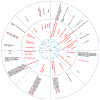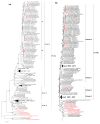Genetic and antigenic evolution of H9N2 avian influenza viruses circulating in Egypt between 2011 and 2013
- PMID: 24990416
- PMCID: PMC4206084
- DOI: 10.1007/s00705-014-2118-z
Genetic and antigenic evolution of H9N2 avian influenza viruses circulating in Egypt between 2011 and 2013
Abstract
Avian influenza virus subtype H9N2 has been circulating in the Middle East since the 1990s. For uncertain reasons, H9N2 was not detected in Egyptian farms until the end of 2010. Circulation of H9N2 viruses in Egyptian poultry in the presence of the enzootic highly pathogenic H5N1 subtype adds a huge risk factor to the Egyptian poultry industry. In this study, 22 H9N2 viruses collected from 2011 to 2013 in Egypt were isolated and sequenced. The genomic signatures and protein sequences of these isolates were analyzed. Multiple mammalian-host-associated mutations were detected that favor transmission from avian to mammalian hosts. Other mutations related to virulence were also identified. Phylogenetic data showed that Egyptian H9N2 viruses were closely related to viruses isolated from neighboring Middle Eastern countries, and their HA gene resembled those of viruses of the G1-like lineage. No reassortment was detected with H5N1 subtypes. Serological analysis of H9N2 virus revealed antigenic conservation among Egyptian isolates. Accordingly, continuous surveillance that results in genetic and antigenic characterization of H9N2 in Egypt is warranted.
Conflict of interest statement
The authors declare no conflict of interest.
Figures





References
-
- Arafa AS, Hagag N, Erfan A, Mady W, El-Husseiny M, Adel A, Nasef S. Complete genome characterization of avian influenza virus subtype H9N2 from a commercial quail flock in Egypt. Virus genes. 2012;45:283–294. - PubMed
-
- Baigent SJ, McCauley JW. Influenza type A in humans, mammals and birds: determinants of virus virulence, host-range and interspecies transmission. BioEssays: news and reviews in molecular, cellular and developmental biology. 2003;25:657–671. - PubMed
-
- Bashashati M, Vasfi Marandi M, Sabouri F. Genetic diversity of early (1998) and recent (2010) avian influenza H9N2 virus strains isolated from poultry in Iran. Archives of virology. 2013;158:2089–2100. - PubMed
Publication types
MeSH terms
Substances
Grants and funding
LinkOut - more resources
Full Text Sources
Other Literature Sources
Medical

